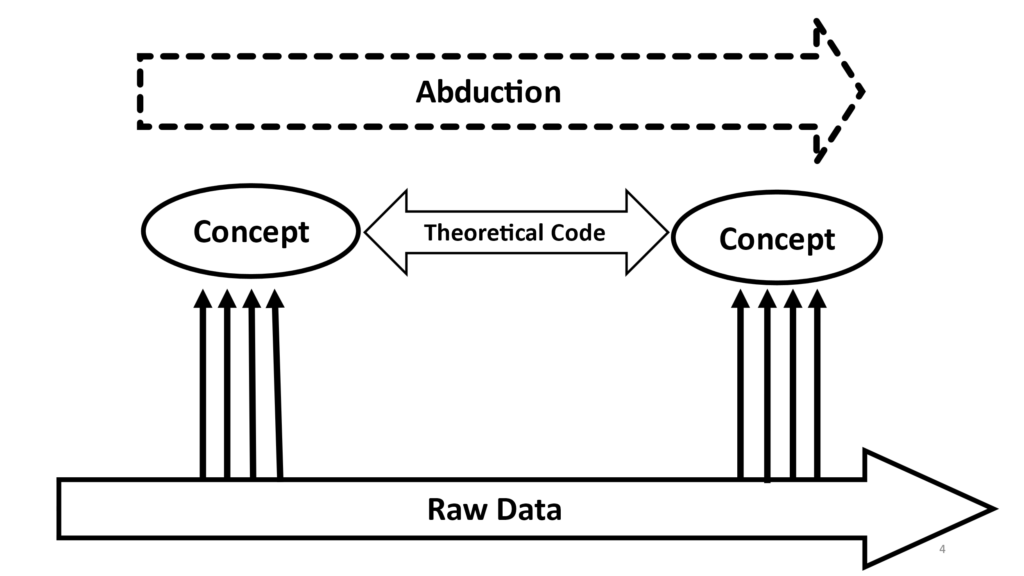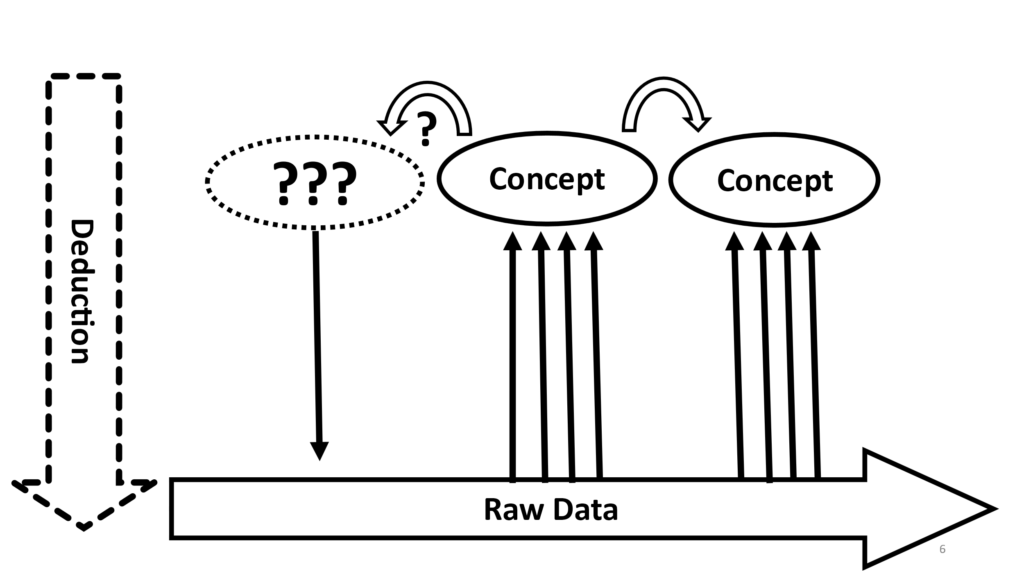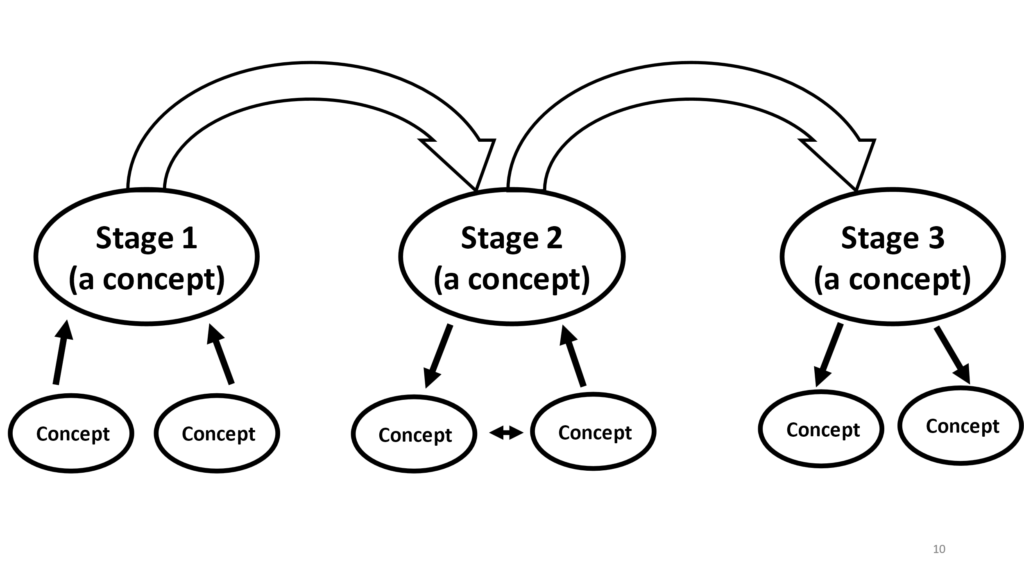
The Logic and Language of Classic Grounded Theory: Induction, Abduction, and Deduction
Alvita Nathaniel, PhD, West Virginia University
Abstract
Although it is not clearly understood by many, classic grounded theory utilizes deduction, induction, and abduction as the necessary logic functions of the research process. Glaser’s described the forms of logic—induction, abduction, and deduction—but referred to them as conceptualization, theoretical coding, and theoretical sampling. Induction begins with data and produces concepts, which are the building blocks of grounded theory. Employing abduction, the analyst infers relationships among the concepts to develop interrelated hypotheses. Deduction is used to gather data to fill in the gaps and produce an explanatory theory. Each type of logic is indispensable to classic grounded theory method. The purpose of this methodological paper is to briefly describe the process and product of each type of logic as applied to the language and procedures of classic grounded theory.
Keywords: grounded theory, research logic, abduction
Introduction
Classic grounded theory is a rigorous method of inquiry that depends upon all three forms of research logic: induction, abduction, and deduction. Deduction and induction, particularly, are common to most other research methods. However, they are used differently and in a different order in classic grounded theory. Noted for developing his own language to describe the grounded theory process, Glaser used the term conceptualization to refer to the process of induction, theoretical coding to refer to the process of abduction, and theoretical sampling to refer to the process of deduction. The purpose of this methodological paper is to describe how the three forms of logic work together to produce a classic grounded theory.
The Logic of Induction: Conceptualization
Induction is always the first step of grounded theory analysis. Inductive research consists of reasoning from particular facts observed in the data to more abstract general principles. In classic grounded theory this occurs when the investigator codes and analyzes the raw data from one case, compares it with codes and data from another (or other) case(s), identifies the common bits in the data (indicators), clusters the indicators together to define a concept, and writes conceptual memos (Glaser, 1978, 1998; Glaser & Strauss, 1967). Coding raw data produces what Glaser calls substantive codes. The word substantive in grounded theory refers to some human experience that has an existence in real life as perceived and communicated by study participants. The grounded theorist collects and examines the raw data and uses the logic of induction to identify substantive codes and then to compare further cases and logically cluster them together to indicate concepts, which are a higher level of abstraction (Fig. 1).
Figure 1: The Process of Induction in Classic Grounded Theory

Thus, unlike other research methods, the foundational process of classic grounded theory is conceptualization, which is grounded in empirical data and clarified through the process of constant comparison. In fact, even before the publication of The Discovery of Grounded Theory (Glaser & Strauss, 1967), Glaser (1965) coined the phrase constant comparative method, which he proposed as a key intellectual strategy of grounded theory analysis. Through constant comparison, indicators are clustered by similarity. Concepts emerge as the analyst goes back and forth in an iterative process constantly comparing the empiric data and writing conceptual memos (Glaser, 1965, 1998). This method increases formal abstraction and corrects for poor data as it brings each concept into closer grounding (Glaser, 1965, 1998, 1999). Abstract concepts derived from empirical data in this way form the building blocks of theory. Procedures of the method move from data collection and conceptualization to abduction.
The Logic of Abduction: Theoretical Coding
Abduction is the type of explanatory reasoning that creates theory. Through inference, abduction connects the dots to arrive at the best explanation. This process is ubiquitous in daily life and is fundamental to grounded theory. First described by Charles Sanders Peirce as a facet of the scientific method, abduction is the process by which consideration of the facts suggests hypotheses (Peirce, 1901/1992, p. 106). Glaser and Peirce both valued abduction as a means to discover new knowledge (Glaser, 1978; Peirce, 1901/1992). Glaser used the phrase theoretical coding when referring to the abductive process. Unlike other research methods that identify and describe themes, abduction (through theoretical coding) moves grounded theory further, producing abstract and explanatory integrated hypotheses.
Figure 2: Abduction Infers Relationships Among Concepts

In grounded theory, after concepts emerge the theorist begins to see how the concepts are interrelated (Fig. 2). Each theoretical code suggests a relationship between concepts. Two concepts and their theoretical code becomes a tentative hypothesis. Perhaps the concepts occur in serial order (a relationship), or one causes another to occur, or one concept forms a critical juncture, interrupting the stage before it. Glaser provided many examples of possible theoretical codes in Theoretical Sensitivity (Glaser, 1978, pp. 74-82) and further in Doing Grounded Theory (Glaser, 1998, pp. 163-145). For example, the theorist may infer from the data that one concept predictably leads to a second concept. The analyst in this example can infer that two concepts are stages, which occur in a certain order. The recognition of that temporal relationship (one stage occurring before the other) forms a tentative hypothesis in this example. Minor concepts may be connected to major concepts in the form, for example, of properties, conditions, or dimensions (all of which are possible theoretical codes). The researcher continues with the analytic process and through abduction (theoretical coding) eventually connects all the hypotheses into a fully integrated theory. Abduction in classic grounded theory makes its start from the concepts and concludes with a theory. It sets classic grounded theory apart from other research methods. Glaser (1998) pointed this out when he wrote, “Without substantive codes, theoretical codes are empty abstractions” (p. 164) and substantive codes without theoretical codes result in confusion that goes nowhere. He wrote further, “It is the interaction between substantive and theoretical coding which characterizes grounded theory [as] an analytic inductive research methodology” (p. 164).
Theoretical codes may be obscure in some theories. Rather than a theory having no theoretical codes, Glaser pointed out that the codes may be implicit. For example, theoretical codes are often implied in a taxonomy. The relationship among categories may be inferred by their position in the taxonomy, perhaps in terms of time or space dimensions. For example, Glaser and Strauss’s (1965) Temporal aspects of dying as a non-scheduled status passage is a taxonomy. In other instances, theoretical codes can be difficult for a reader to tease out, even in an excellent grounded theory, if the theory includes an integration of conceptual and descriptive narrative (Glaser, 2005). Nevertheless, theoretical codes, whether obvious or obscure, are one of the main elements that characterize classic grounded theory.
So, as analysis continues and because classic grounded theory begins with no preconceived problem, the combination of conceptualization and theoretical coding (induction and abduction) will begin to reveal a theory—one that may not be entirely complete. At this point, the investigator moves back to the data using a deductive process that Glaser called theoretical sampling.
The Logic of Deduction: Theoretical Sampling
In classic grounded theory, deduction serves to complete a theory. Classic grounded theories emerge from the data, so unlike other methods that use deduction to verify a preconceived theory or hypothesis, deduction in grounded theory is not determined in advance of a study. With the grounded theory approach, the investigator constructs the theoretical framework out of the data. As a grounded theory begins to emerge through the processes of induction and abduction, the investigator will recognize gaps in the theory and make inferences about the proper direction of subsequent data gathering. Glaser proposed that deduction guides the researcher back to locations and comparative groups in the field to discover more ideas and connections from data. According to Glaser (1978), “Deductive work in grounded theory is used to derive … where to go next for which comparative group or subgroup, in order to sample for more data to generate the theory” (p. 37). Thus, deduction points to the most appropriate avenue for further investigation and subsequently fills gaps in a theory (Fig. 3).
Figure 3: Deduction Fills Gaps

Unlike research methods that rely primarily on deduction, in classic grounded theory deduction “is in the service of further induction” (Glaser, 1978, p. 38). Thus, deduction via theoretical sampling is used to discover a fully integrated explanatory theory and to uncover data that otherwise might be overlooked. As noted above, the researcher continues with the analytic process of induction, abduction, and deduction to eventually connect all the hypotheses into a fully integrated theory. Figure 4 is an example of what the structure of a fully integrated theory might look like. Although Glaser objected to reliance on models to illustrate theories, the model in Figure 4 depicts a hypothetical three-stage theory with sub-concepts (such as properties or dimensions) and their directional relationships, which would be further named, defined, and described in the theory’s narrative. Relationships between concepts form a theory’s hypotheses. For example, if asked, the theorist could name at least nine separate hypotheses (count the arrows) in a theory similar to the Figure 4 model.
Figure 4: Sample Model Depicting Hierarchical Concepts and Their Theoretical Relationships

Conclusion
Classic grounded theory as described by Glaser and Strauss (1967) and Glaser (1965, 1978, 1992, 1998, 2002, 2005, 2014) utilizes deduction, induction, and abduction as iterative components of the research process. Glaser’s terms conceptualization, theoretical coding, and theoretical sampling reflect the more familiar terms for the three types of research logic: induction, abduction, and deduction. Induction begins with data and produces concepts, which are the building blocks of grounded theory. Employing abduction, the analyst infers relationships among the concepts to develop interrelated hypotheses. Deduction is used to gather data to fill in the gaps and produce an explanatory theory. Each type of logic is indispensable to classic grounded theory method.
References
Glaser, B. G. (1965). The constant comparative method of qualitative analysis. Social problems, 12(4), 436-445.
Glaser, B. G. (1978). Theoretical sensitivity: Advances in the methodology of grounded theory. Sociology Press.
Glaser, B. G. (1992). Basics of grounded theory analysis: Emergence vs forcing. Sociology Press.
Glaser, B. G. (1998). Doing grounded theory: Issues and discussion. Sociology Press.
Glaser, B. G. (1999). The future of grounded theory [serial online]. Qualitative Health Research, 9(6), 10.
Glaser, B. G. (2002). Conceptualization: On theory and theorizing using grounded theory. International Journal of Qualitative Methods, 1(2), 1-31.
Glaser, B. G. (2005). The grounded theory perspective III: Theoretical coding. Sociology Press.
Glaser, B. G. (2014). Memoing: A vital grounded theory procedure. Sociology Press.
Glaser, B. G., & Strauss, A. L. (1965). Temporal aspects of dying as a non-scheduled status passage. American Journal of Sociology, 71, 48-59. http://www.ncbi.nlm.nih.gov/entrez/query.fcgi?cmd=Retrieve&db=PubMed&dopt=Citation&list_uids=14336667
Glaser, B. G., & Strauss, A. L. (1967). The discovery of grounded theory: Strategies for qualitative research. Aldine Transaction.
Peirce, C. S. (1901/1992). On the logic of drawing history from ancient documents. In N. Houser & C. Kloesel (Eds.), The Essential Peirce: Selected Philosophical Writings (Vol. 2). Indiana University Press.
Declaration of Conflicting Interests: The author declared no potential conflicts of interest with respect to the research, authorship, and/or publication of this article.
Funding: The author received no financial support for the research, authorship, and/or publication of this article.













